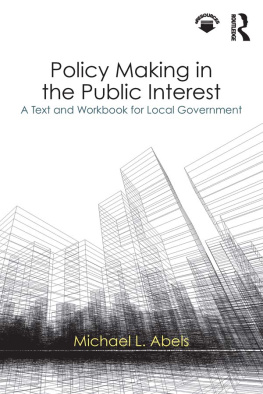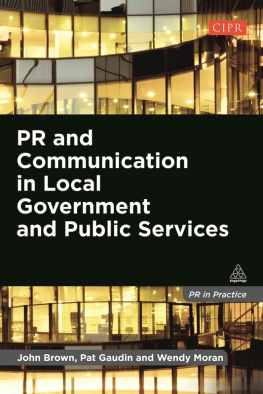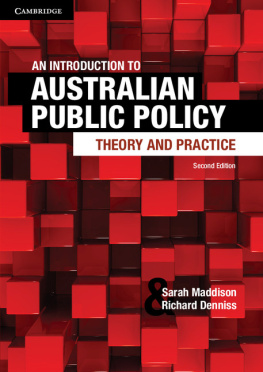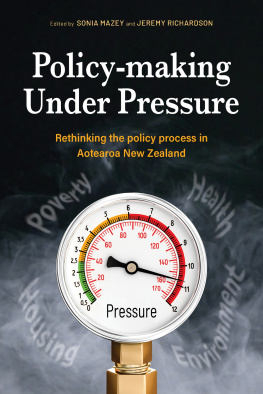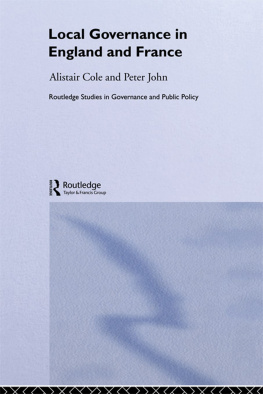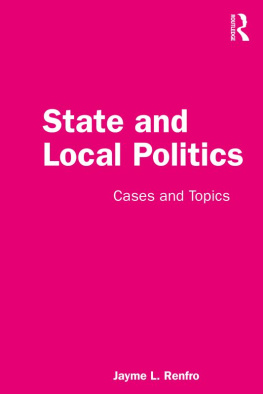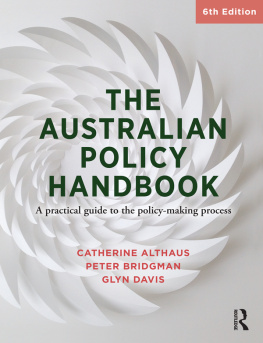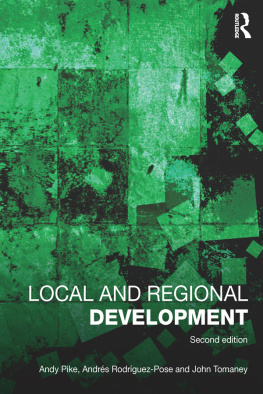Policy Making in the Public Interest
Policy Making in the Public Interest is the first text and workbook to provide a short and firmly focused introduction to the techniques that may be used in local government for policy making in the public interest. Each chapter introduces core policy concepts and competencies and concludes with exercises that encourage the reader to apply the theme of the chapter to a practical policy issue in local government, such as city-planning, community governing, public interest goals, developing partnerships, sustainability concerns, and comparative analyses.
The exercises explore issues students are likely to analyze as interns in local government or observe in a service-learning assignment with local government. For practitioners and elected officials, the exercises focus on issues commonly confronted on the job. This unique approach is designed specifically to lead the reader to a complete and multi-dimensional understanding of the public interest and to provide tools for identifying and adopting local government policies that will support it. Throughout the book, the reader is an interactive participant completing assignments that complement the written material in the text. An accompanying website contains grading forms to evaluate verbal presentations and analytical work, PowerPoint slides for instructors to use to teach the analytical processes presented in the book, downloadable forms for students and practitioners, as well as links and references to other sources of information the organization may wish to reference (e. g., strategic planning resources). Policy Making in the Public Interest is an essential read as a text and workbook for classes in public policy or local government operations, as a self-guided text for managers and elected officials, and as a resource and instructional guide for workshops.
Michael L. Abels served as a Lecturer and Undergraduate Program Director in the School of Public Administration, University of Central Florida, United States, from 2008 to 2016. Prior to 2008, he served for approximately 35 years in city management and as the Chief Executive Officer for several non-profit organizations.
Policy Making in the Public Interest
A Text and Workbook for Local Government
Michael L. Abels
First published 2018
by Routledge
711 Third Avenue, New York, NY 10017
and by Routledge
2 Park Square, Milton Park, Abingdon, Oxon, OX14 4RN
Routledge is an imprint of the Taylor & Francis Group, an informa business
2018 Taylor & Francis
The right of Michael L. Abels to be identified as author of this work has been asserted by him in accordance with sections 77 and 78 of the Copyright, Designs and Patents Act 1988.
All rights reserved. No part of this book may be reprinted or reproduced or utilised in any form or by any electronic, mechanical, or other means, now known or hereafter invented, including photocopying and recording, or in any information storage or retrieval system, without permission in writing from the publishers.
Trademark notice: Product or corporate names may be trademarks or registered trademarks, and are used only for identification and explanation without intent to infringe.
Library of Congress Cataloging-in-Publication Data
A catalog record for this book has been requested
ISBN: 978-1-138-06480-5 (hbk)
ISBN: 978-1-138-06481-2 (pbk)
ISBN: 978-1-315-16018-4 (ebk)
Typeset in Sabon
by Florence Production Ltd, Stoodleigh, Devon, UK
Visit the eResources: www.routledge.com/9781138064812
Contents
PART I
Public Interest and Trends for the Future
PART II
Identifying the Community Public Interest
PART III
Tools for Policy Analysis
Leaders establish the vision for the future and set the strategy for getting there.
John P. Kotter
Serving as a city manager during the last two decades of the twentieth century and the first decade of the twenty-first century, I witnessed a fundamental shift in the responsibilities, as well as the role for local government. As our political system has disparaged government in general, and the federal government in particular, more responsibility for societal services has shifted to local government. Concurrent with this fundamental change, the world has significantly transformed over the past three decades, socially, economically, and especially politically. Local governments, whether cities or counties, are no longer unitary entities delivering a set of clearly identifiable services to a geographically defined population. In the twenty-first century, local government must be viewed as a regional networked system consisting of cities, counties, private businesses, civic organizations, non-profit organizations, religious institutions, and citizens which together identify problems and issues, and deliver an assortment of emerging services that address very complex and interconnected issues.
Witnessing this radical transition in societal norms, I along with other managers and elected officials struggled, searching for a policy model through which our local governments could respond to their new role, a model that would facilitate success in addressing the responsibilities into which our governments were evolving. We discussed the question is there a better way to formulate public policy, one that moves policy away from narrowly focused constituency groups such as development or anti-development groups, one that reduces the policy domination of Citizens Against Virtually Everything (CAVE) and Not in My Back Yard (NIMBY) groups? Is there a model that instead allows policy to be centered on the broad community public interest? Are there tools that will allow local government to define the public interest as the public interest applies to specific localities, and then, by centering on the public interest, proactively and effectively respond to the complexity and diversity of our local communities? Our discussions always concluded by a consensus understanding that managers and elected officials are continuously searching for ways and means to work in common cause with their citizens, all in pursuit of the common good for their communities. Traveling on this journey, managers and elected officials need vision, strategies, and analytical tools that can help them to successfully complete their journey.
Goals for This Book
This policy text-workbook seeks to answer those questions. To provide these answers, this book has two goals. The first is providing a planning and management system that can be used by local government managers and elected officials to formulate public policy centered on the public interest. The second goal is to provide a learning platform for students of public policy, one centered on the public interest. This book is designed as a reality-based structure that students may apply to issues and problems faced by a unit of local government to which they are assigned as interns, or as a service-learning project. Through their work as student policy analysts, students will be fully prepared to assume positions in public or non-profit organizations where they will recommend and analyze optimum policy solutions to meet the unrealized needs, opportunities for improvement, or the values possessed by the citizens their organization serves.
In addressing the first goal, it is recognized that elected officials and appointed managers approach the policy process from different perspectives, and with different responsibilities. Therefore, elected officials should approach the technical material described in using a different perspective than do appointed managers. However, the starting point for both elected officials and managers is the same; policy setting must be founded on the broad public interest, with the orientation to the public interest embedded as a controlling value for the local government.

